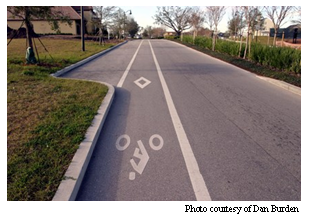Bicycling Existing Conditions
Existing Conditions
The existing conditions for bicycling (and walking) throughout the northeastern Illinois region have been documented and analyzed in great detail in Soles and Spokes: The Pedestrian and Bicycle Plan for Chicago Area Transportation prepared by the Chicago Area Transportation Study (CATS) in 2004. (CATS 2004, particularly "Task 2 Report") We encourage readers interested in a more detailed discussion of bicycling in northeastern Illinois to become familiar with the Soles and Spokes program.
In addition, CMAP has created and maintains a Bicycle Information System (BIS). The BIS is an inventory of all local and subregional bikeway plans, as well as northeastern Illinois' Greenways and Trails plan (adopted by NIPC in 1997 and currently being updated). Plans are compiled in the BIS and are mapped as the Strategic Regional Bicycle and Pedestrian System Map (PDF - 10 MB). Given the regional scope of the BIS and its inclusion of planned and future routes, the map is not intended to function as a user's map. Rather its value and use is as a planning tool to help officials, planners, and transportation agencies understand, communicate, and coordinate efforts to accommodate bicyclists and other non-motorized modes of travel in our region. The BIS enables implementers of individual transportation and development projects to identify existing and planned bicycle facilities in the area of their projects and to integrate these plans into their designs.
Developing and improving the regional bikeway network – as well as other facilities and opportunities for non-motorized travel – is an important part of our overall regional development strategy. Specific policy recommendations and guidance in both the Regional Transportation Plan (RTP), and in the 2040 Regional Framework Plan affirm this fact and clearly express the importance of such a strategy.
The 2030 Regional Transportation Plan, most recently updated and approved in June 2007, discusses pedestrian and bicycle travel in "Chapter 5: Strategic Regional Systems". The plan strongly encourages shared-use, multi-modal design of roadways and states that "bicycle and pedestrian transportation strategies that encourage non-motorized travel and improve the quality of walking and biking trips are integral to successful shared-use design." Increasing bicycle (and pedestrian) travel would directly help acheive a number of the RTP's stated objectives, including better mobility and accessibility, system efficiency, public health and safety, and community and economic development. Specifically, it makes the following recommendations:
The RTP recommends strategic improvements to shared-use facilities that foster "routine accommodation" of pedestrian and bicycle design in all transportation projects and services…The RTP recommends that project implementers consider a facility's potential use by bicycle and pedestrian travelers and make appropriate design accommodations using flexibility included in most highway design manuals…[Routine accommodation] includes pursuing improvements that support bicycle and pedestrian access to transit and providing bicycle and pedestrian travel information and promotion as part of larger management and operation strategies applied to the entire transportation system. (CATS 2007).
Finally, the RTP lists a number of specific ways that communities and implementing agencies can make roadways and other transportation infrastructure safer and more convenient for bicyclists and pedestrians.
The Northeastern Illinois Planning Commission's (NIPC) 2040 Regional Framework Plan, focusing on land use and the promotion of sustainable development patterns throughout the region, recommends "Promotion of Walking and Biking as Alternative Modes of Travel" as one of 17 major strategies to achieve the vision of the region. The plan discusses the synergistic, mutually supportive ways in which improving bicycling and walking conditions support and are supported by other important goals of the plan, such as compact development, mix of uses, promotion of transit, reduction of barriers between neighborhoods and communities, increased public health and safety, and equitable mobility and access. Overall, the 2040 Regional Framework Plan recommends that bicycle and pedestrian connections be ubiquitous in fully urbanized parts of the region and that bicycle and pedestrian connections linking centers be developed in less urbanized areas.
|
Past plans by CATS and NIPC (CMAP's predecessor agencies) have taken an active and direct approach to recommending bicycle facilities. Is there anything that CMAP should do in its long-range planning beyond what has been done in past plans concerning bicycling? |